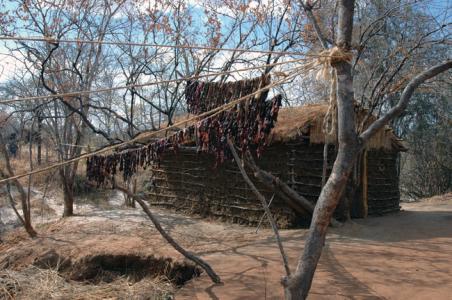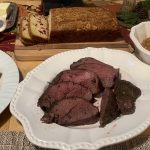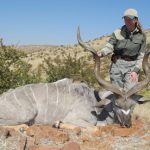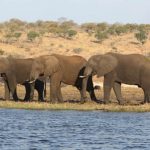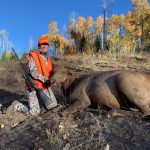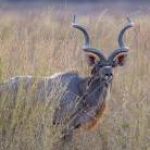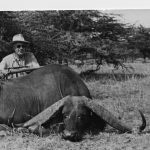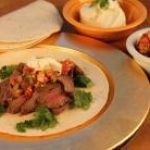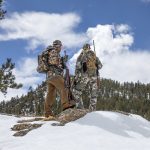A new study of game management areas in Zambia highlights the importance of the meat provided to local communities by hunting outfitters.
When hunters travel to Africa for a safari hunt, their friends back home often wonder what happens to the meat of the animals they kill. If you’ve been on an African safari, you know that some of the meat is eaten in camp. But most of it, especially in the poorest and most rural areas of the continent, is given to the local communities, where it is a crucial addition to the otherwise protein-deficient diet of much of the populace.
Until now, there have been few, if any, scientific studies attempting to quantify the amount of game meat that goes to local communities and the impact it has. That has changed with a just-published study of three game management areas (GMAs) in several regions of Zambia that assessed the quantity and impact of sport-hunted meat provided to the local communities between 2004 and 2011.
The study, entitled “Provisioning of Game Meat to Rural Communities as a Benefit of Sport Hunting in Zambia,” was authored by Dr. Paula A. White and Jerrold L. Belant and appeared in the online scientific journal PLOS One, published February 18, 2015. White is the Director of the Zambia Lion Project and a Senior Research Fellow at the UCLA Center for Tropical Research. Belant is an Associate Professor of Wildlife Ecology and Management at Mississippi State University and Director of the Carnivore Ecology Laboratory. White, who conceived of the study and conducted the on-the-ground data collection, is extremely familiar with the GMAs in Zambia, having spent more than ten seasons doing carnivore research in the region.
As part of their lease agreements with the Zambia Wildlife Authority, hunting operators in Zambia are required to give to the local communities in their GMAs more than 50 percent of the meat obtained by their hunting clients. How much does that amount to? The study found that the rural communities located within each GMA where sport hunting occurred received an average of more than 13,277 pounds of fresh game meat annually from hunting operators. Extrapolating the results across all thirty GMAs in Zambia, the study estimated 286,000 pounds of fresh game meat are provided annually by the sport hunting industry to rural communities in Zambia.
Game meat drying for biltong at a hunting camp in Africa. The new study quantifies how important such meat is to people who live near safari camps.
The study authors also wanted to find out how well the outfitters were complying with their requirement to provide this meat, so they compared the amount of meat expected based on the quotas for each GMA versus the amounts that the communities actually received during a three-year segment of the study period. In seven of eight annual comparisons of these three GMAs, the amount of meat the communities received exceeded what was required. The meat donations occurred throughout the May-to-November hunting season, but the largest amount of meat was given to the communities in September and October, which is about the same time rural Zambians are most likely to run short of food since their crops are not yet ready to harvest.
The estimated annual cost to purchase the equivalent of 286,000 pounds of fresh game meat would be more than US$600,000, not including butchering and delivery costs. Using an estimate of 20 percent protein per 100 grams of game meat, the meat from the GMAs provided the equivalent of 519,084 people-days of protein per year. This figure is based on the recommended daily protein requirement of 50 grams per day.
To put this in perspective, studies show that 48 percent of Zambia’s population is classified as undernourished, and their recommended daily protein requirements are rarely met. Most Zambians actually get less than 20 percent of their dietary energy from animal protein. That’s because, to obtain protein other than the donated meat, rural Zambians, who cannot legally hunt for themselves, have three choices: raise their own livestock, fish, or buy meat. In many areas of rural Zambia inadequate grazing or the presence of tsetse flies makes raising livestock impossible. To fish legally requires purchasing a permit and having access to water, and purchasing meat is prohibitively expensive for most Zambians, who live on less than US$1 per day.
“Thus, although meat provisioned by sport hunting operators represents a small percentage of protein requirements for Zambians overall, it appears an effective means of distributing fresh, high-quality meat to some of the most remote areas of the country with the greatest protein needs, thereby partially alleviating protein deficiencies in rural Africans,” the authors concluded.
“As I began to examine the data in depth, I was surpised by the large amount of meat that was being distributed,” said White. “I was also surprised at the paucity of scientific studies that examine how hunting activities can directly support conservation. There is a wealth of colloquial information, but it rarely gets quantified or distributed in a manner that helps demonstrate the benefits that hunting can provide, in this case to rural communities in Africa.”
The paper goes on to discuss a recent, tragic development related to the original study: A hunting moratorium that was put in place during 2013 and 2014 throughout most of Zambia’s GMAs meant the game meat normally donated by the hunting industry was eliminated. This created a crisis, made worse by the fact that rural areas of Zambia are not exactly overloaded with employment opportunities. The jobs provided by hunting camps were lost during the moratorium, and the items that the hunting camps usually buy from local communities (grass for thatching, vegetables, cornmeal) were not needed. The upshot was that, in addition to losing their supply of donated meat, many rural Zambians lost the income that would have allowed them to purchase meat.
Under these circumstances, the locals can hardly be blamed for doing their own hunting. Unfortunately, the indiscriminate methods used by the local “bushmeat” hunters, such as the use of crude snares and the overharvesting of females and young animals, are unsustainable and quickly lead to the depletion of wildlife populations throughout a wide area–unlike legal safari hunting, which is carefully controlled by quotas and regulations. It’s unquestionable, the study authors said, that the severity and rate of bushmeat poaching escalated during the hunting closure. It is uncertain if any of the GMAs affected by the moratorium will be reopened to hunting this year.
“In the absence of legitimate operators, the GMAs will continue to get encroached upon by humans and livestock, and hammered by poachers as has been happening throughout the last two years,” White said. “The communities feel forgotten and are getting by however they can. It is hard to watch, but given what they have lost during the moratorium–meat, jobs, money–and the uncertainty of their future, it is hard to blame them. Right now, they are just trying to survive any way they can.”
Read the full text of the study HERE.

